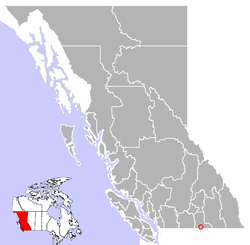Greenwood | |
|---|---|
| The Corporation of the City of Greenwood | |
 | |
 Location of Greenwood in British Columbia | |
| Coordinates: 49°05′24″N118°40′39″W / 49.09000°N 118.67750°W | |
| Country | Canada |
| Province | British Columbia |
| Region | Boundary Country |
| Regional district | Kootenay Boundary |
| Incorporated | 1897 |
| Government | |
| • Mayor | John Bolt |
| • Council | Jessica McLean, Gerry Shaw, Clint Huisman, Jim Nathorst |
| Area | |
• Total | 2.52 km2 (0.97 sq mi) |
| Elevation | 770 m (2,530 ft) |
| Population (2021) | |
• Total | 702 |
| • Density | 280/km2 (720/sq mi) |
| Time zone | UTC-8 (PST) |
| • Summer (DST) | UTC–7 (PDT) |
| Zip code | V0H 1J0 |
| Area codes | 250, 778, 236, 672 |
| Highways | 3 |
| Website | greenwoodcity |
Greenwood (2021 population 702) is a city in south central British Columbia. It was incorporated in 1897 and was formerly one of the principal cities of the Boundary Country smelting and mining district. [1] It was incorporated as a city originally and has retained that title despite the population decline following the closure of the area's industries.
Contents
The town is served by Greenwood Elementary School which covers grades from K-7. Following grade 7 local students attend Boundary Central Secondary School in nearby Midway.
In 1942, 1,200 Japanese Canadians were sent to Greenwood as part of the Japanese Canadian internment. [2] Among those interned at Greenwood were Isamu and Fumiko Kariya and their son Yasi, the grandparents and uncle of NHL star and Hockey Hall of Fame member Paul Kariya; his father Tetsuhiko (T.K.) was born in internment. [3]
